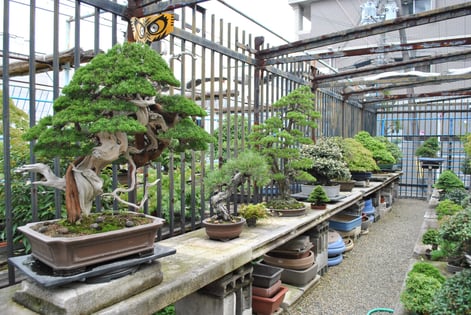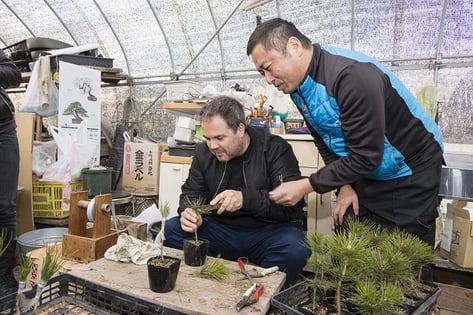🕓 2025/2/25
#文化
Detailed explanation of the history and experience of bonsai
.png?width=792&height=453&name=DALL%C2%B7E%202023-12-24%2000.19.10%20-%20A%20beautiful%20and%20serene%20image%20of%20a%20classic%20bonsai%20tree%2c%20symbolizing%20the%20art%20and%20tradition%20of%20bonsai%20cultivation.%20The%20bonsai%20tree%20is%20depicted%20in%20a%20peace%20(1).png)
Table of Contents
- 1. What is Bonsai
- 2. The History of Bonsai
- 3. Types of Bonsai
- 4. Standards for Bonsai Creation
- 5. Places to Experience and Feel Bonsai
1. What is Bonsai
Bonsai is a traditional Japanese art form, meaning "planted in a container."
Its origins lie in ancient Chinese horticultural techniques. In this technique, normal plant stocks or seeds are used to grow small trees.

The process involves pruning branches and roots and using wire to shape them, imitating the appearance of mature trees on a smaller scale.

Bonsai is treasured as an art piece that recreates the beauty of nature on a small scale, offering tranquility to its viewers. This art is loved worldwide as part of Japanese culture, and its tradition is carried on by many enthusiasts.

2. The History of Bonsai
The history of bonsai begins with ancient Chinese horticultural techniques and spans over 2000 years. It was introduced to Japan about 700 years ago, where it evolved into its unique art form.

Initially, bonsai had a strong significance as religious memorabilia but gradually became popular among Japanese cultural figures and became known as bonsai.

This art was loved across generations, widely accepted from shoguns to common people.

In Japan, bonsai became a source of introspection, expressing the beauty of nature in a miniature form.

Furthermore, bonsai, as an important part of Japanese culture, is highly regarded both domestically and internationally. Through the history of bonsai, Japanese views of nature, aesthetics, and spirituality are reflected, and these continue to be passed down by enthusiasts worldwide.

3. Types of Bonsai
There are various types of bonsai, each with its own unique characteristics. Some of the representative types include:
・Ficus Bonsai
Characterized by glossy leaves, Ficus bonsai are adaptable to various environments. Popular types include Ficus Benjamina (Weeping Fig) and Ficus Retusa (Ginseng Ficus). These are beginner-friendly and suitable for indoor cultivation.
・Flowering Bonsai
ncludes varieties that produce beautiful flowers, such as Satsuki Azalea and Japanese Cherry Blossoms. These are favored by many bonsai enthusiasts for enjoying seasonal changes. They are characterized by colorful and vibrant flowers.
・Baobab Bonsai
Baobab bonsai use trees native to Africa, known for their thick, bottle-shaped trunks, making them an unusual choice for bonsai. The distinctive appearance of Baobab trees has garnered significant interest among bonsai enthusiasts.
・Judas Tree Bonsai%20bonsai%2c%20known%20for%20its%20stunning%20pink%20blossoms%20in%20spring.%20The%20image%20captures%20the%20Judas%20Tree%20bonsai%20in%20fu.png?width=461&height=263&name=DALL%C2%B7E%202023-12-23%2023.59.35%20-%20An%20exquisite%20depiction%20of%20a%20Judas%20Tree%20(Cercis)%20bonsai%2c%20known%20for%20its%20stunning%20pink%20blossoms%20in%20spring.%20The%20image%20captures%20the%20Judas%20Tree%20bonsai%20in%20fu.png)
Known for producing vibrant pink flowers in spring, Judas Tree bonsai are popular for their beautiful blossoms. They allow for the enjoyment of seasonal changes in bonsai. The leaves of this tree also change to vivid colors in autumn, offering visual pleasure throughout the year. Proper sunlight and watering promote healthy growth in Judas Tree bonsai.
4. Standards for Bonsai Creation
The creation of bonsai begins with selecting the right materials.

Using saplings or cuttings, the shape is carefully crafted to meet aesthetic standards. This process includes techniques such as pruning, wiring, and repotting.

These techniques are used to imitate the appearance of large trees in nature, infusing bonsai with a sense of life and beauty. The goal is to perfectly recreate nature's beauty on a small scale, elevating the bonsai to an art piece.

Pruning controls branch growth, wiring adjusts the direction of branches and trunks, and repotting maintains a healthy root system. These techniques allow the bonsai to mature over time, offering deep beauty to its viewers.

5. Places to Experience and Feel Bonsai
・Omiya Bonsai Village
Located in Saitama City, Saitama Prefecture, Omiya Bonsai Village is one of Japan's most famous bonsai centers. It houses numerous bonsai gardens and a bonsai museum, where one can learn about the history and techniques of bonsai culture. Visitors can view various types of bonsai and participate in bonsai-making workshops.
・Fujikawa Kouka-en
Located in Ikeda City near Osaka, Fujikawa Kouka-en is a gathering place for bonsai enthusiasts and students from both Japan and abroad. It offers not only beautiful bonsai displays but also short-term classes and training programs.
・Shunkaen Bonsai Museum
Operated by bonsai master Kunio Kobayashi, the Shunkaen Bonsai Museum in Edogawa, Tokyo, displays amazing ancient bonsai, including pines over a thousand years old. It also offers bonsai classes and apprenticeship programs.
・Kagawa Setouchi Art Tourism Zone
Visitors can explore the over 130-year-old bonsai garden "Konishi Shorakuen," guided by its fourth-generation owner who has dedicated 20 years to the craft. Learn to distinguish good from bad bonsai and understand the worldview expressed by bonsai, while experiencing the different seasonal care activities.
